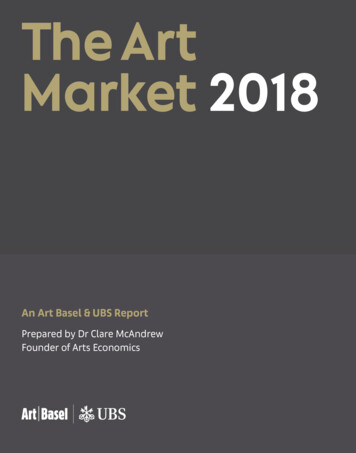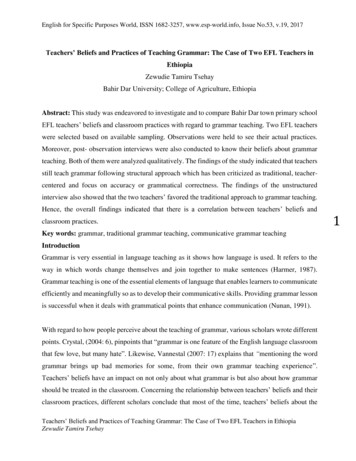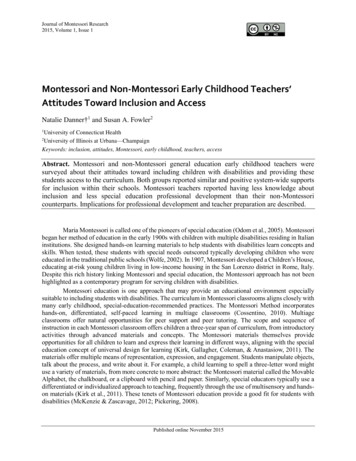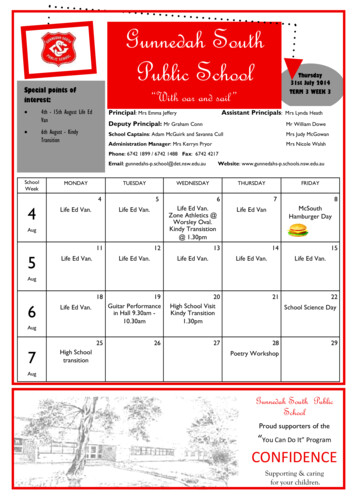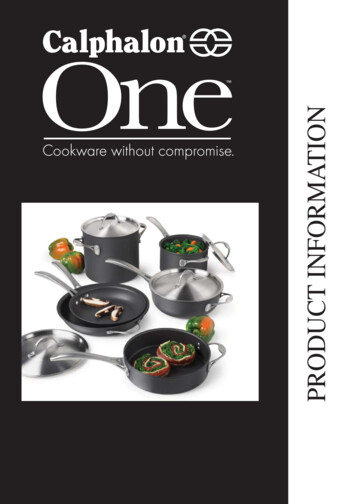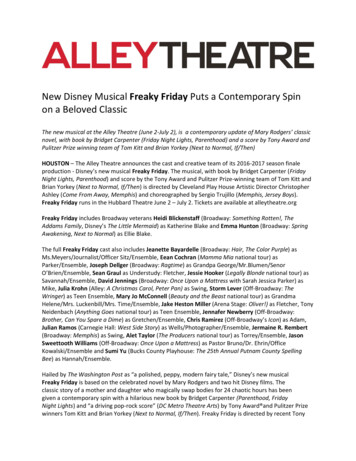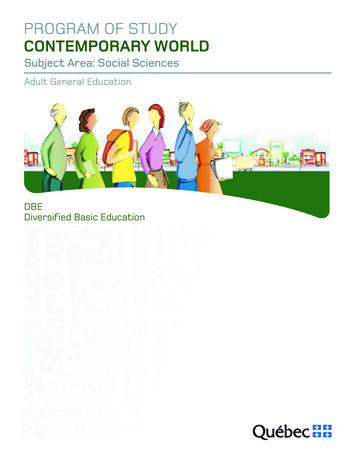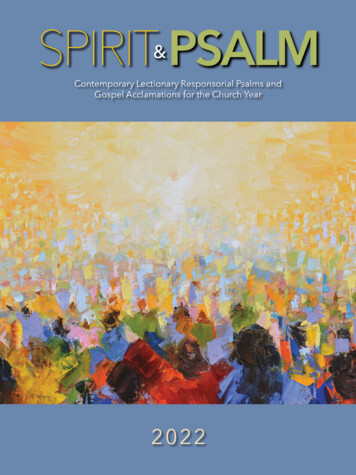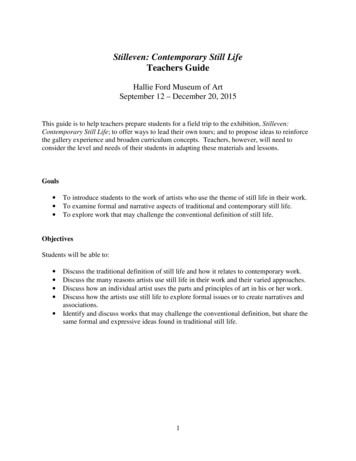
Transcription
Stilleven: Contemporary Still LifeTeachers GuideHallie Ford Museum of ArtSeptember 12 – December 20, 2015This guide is to help teachers prepare students for a field trip to the exhibition, Stilleven:Contemporary Still Life; to offer ways to lead their own tours; and to propose ideas to reinforcethe gallery experience and broaden curriculum concepts. Teachers, however, will need toconsider the level and needs of their students in adapting these materials and lessons.Goals To introduce students to the work of artists who use the theme of still life in their work.To examine formal and narrative aspects of traditional and contemporary still life.To explore work that may challenge the conventional definition of still life.ObjectivesStudents will be able to: Discuss the traditional definition of still life and how it relates to contemporary work.Discuss the many reasons artists use still life in their work and their varied approaches.Discuss how an individual artist uses the parts and principles of art in his or her work.Discuss how the artists use still life to explore formal issues or to create narratives andassociations.Identify and discuss works that may challenge the conventional definition, but share thesame formal and expressive ideas found in traditional still life.1
INDEXINTRODUCTION .3BEFORE THE MUSEUM VISIT/AT THE MUSEUM .4THREE STILL LIFES 5ART-MAKING CONNECTION .11LANGUAGE ARTS CONNECTION .12IMAGES .142
INTRODUCTIONJohn Olbrantz, The Maribeth Collins Director and exhibition co-curatorA still life is a work of art that depicts mostly inanimate objects, either natural (food,flowers, plants, rocks, animals) or man-made (cups, saucers, glasses, jewelry, tables).With its origins in antiquity and the late Gothic period, still-life painting emerged as animportant theme in Western painting by the late sixteenth and early seventeenthcenturies. While still life reached its zenith in the hands of the Dutch and Flemish mastersof the seventeenth century, it has continued to be an important if under-recognized themein American and European art for the past three centuries.Stilleven (the Dutch word for “still life” and pronounced “sti-lay-ven”) celebrates thework of contemporary artists from Oregon, Washington, Idaho, Montana, and BritishColumbia who focus on still-life themes in their artwork. Organized by Director JohnOlbrantz and Collection Curator Jonathan Bucci, the exhibition is intended to reaffirmand in some cases challenge traditional notions of still life imagery. Indeed, during thelast four decades of the twentieth century and the early years of the twenty-first, still lifehas expanded beyond the simple observation of inanimate objects to embrace a widevariety of intentions and approaches.Some of the artists included in the exhibition, like Norman Lundin and Eric Elliott, usestill-life themes to explore formalist issues of atmosphere and light, while others likeAmjad Faur use still life to make social or political statements. David Giese createswildly fanciful and improbable still-life compositions based on a fictitious privateresidence that he claims to have discovered in the Piedmont region of northern Italy,while John Feodorov and Karen Hackenberg use still-life themes to addressenvironmental issues such as waste, pollution, and the importance of recycling. Still otherartists like Margie Livingston and Ben Frank Moss use the simple concept of arrangedobjects as a means to explore materials and processes.For many artists in the exhibition, art-historical references abound. Dutch-born painterHenk Pander references traditional Dutch still life in many of his works, while artistsKatherine Ace and Sarah Fagan create still-life paintings that recall the work of suchnineteenth-century American trompe l’oeil (a French term that means “to trick or fool theeye”) painters John F. Peto and William Harnett. Mixed-media artists Whiting Tennis andBlair Saxon Hill have both been heavily influenced by Cubist collage, while painter andprintmaker Sherrie Wolf and photographer and installation artist Wendy Given offerfresh approaches to traditional still-life themes and motifs.3
BEFORE THE MUSEUM VISIT If possible, visit the exhibition on your own beforehand.Use the images and suggested discussions and activities to introduce students tocontemporary still life.Make sure students are aware of gallery etiquette.AT THE MUSEUM Review with students what is expected – their task and museum behavior.Be selective – don’t try to look at or talk about everything in the exhibition.Focus on the works of art. Encourage students to look closely at each work of art andconsider beginning with the visual scanning they used in the classroom as well as thesuggested discussions (see below). A good way to start is by asking, “What is happeningin this picture?” or “what do you see here?” Follow with questions that will help studentsback up their observations: “What do you see that makes you say that?” or “Show uswhat you have found.” Describe what you see here: your first impressions of subject matter, and ifapplicable, scene, mood and atmosphere. How has the artist used the elements of art (lines, color, shape, form, texture, space,etc.) and the principles of art (the way it is organized, i.e., pattern, contrast, balance,proportion, unity, rhythm, variety, emphasis)? Does the artist seem to be more interested in the subject matter or formal issues?o How important is the object (or objects) – its realistic depiction, its inherentbeauty, etc. – to the artist? Explain.o Is the artist sending a message, telling a story or making associations for theviewer or the does the work seem to be more about how the artist uses color,texture, contrast, space, etc.? Or both? Explain Does this work fit the traditional definition of still life? If not, does it share some of thesame themes or concerns? Explain.4
THREE STILL LIFESStill life is traditionally defined as a work of art depicting inanimate, often commonplace objectsthat are either natural (fruit, flowers, etc.) or man-made (vases, glasses, books, etc.) in anartificial setting. As a demonstration of artistic skill and symbolic expression, still life hasremained a popular art form for centuries. In the exhibition, Stilleven: Contemporary Still Life,you will find Northwest artists who choose the still life genre to explore formal issues and/or tocreate narratives and express ideas. You will also find artists whose work may challenge thegenre’s conventional definition, but share the same formal and expressive ideas found intraditional still life.Eric Elliott(American, b. 1975)Morning Light2009Oil on canvasCollection of the Hallie Ford Museum of Art,Willamette University, gift of Josef Vascovitz,2014.024In the tradition of earlier still life artists, Eric Elliott has chosen still life as a vehicle for hisexplorations of formal issues such as shape, color, value, and light. His beautifully renderedworks capture the mood and atmosphere of simple everyday objects and spaces.About the artist: Eric Elliott lives in Seattle, Washington. He has exhibited his workextensively in the Seattle area and received a Neddy Artist Fellowship in 2009. Eric teaches atGage Academy of Art and has had residencies at the Vermont Studio Center and the JerusalemStudio School. He earned a BA from University of California, Berkeley, and an MFA from theUniversity of Washington.Suggested Discussion: Briefly describe what you see here: your first impressions of subject matter, scene, moodand atmosphere. How has the artist used the elements of art (lines, color, shape, form, texture, space, etc.)and the principles of art (the way a work is organized, i.e., pattern, contrast, balance,proportion, unity, rhythm, variety, emphasis)?o Where does your eye go first? Why?5
o How does your eye move around the painting – is it led by color? By shape? Bypattern? By size?o Describe the color. Has the artist used it realistically? How does the color contributeto the atmosphere and mood?o How has the artist used light? Describe the quality of light – its intensity, whether itis directional or all over, does it create clear or soft outlines, etc. How does the lightcontribute to the atmosphere and mood?o Does this scene appear realistic? Dreamlike? Both? Explain. Discuss the following statements by the artist in relationship to Morning Light. Do theygive you new insight into his work? Explain.o “Painting is my primary connection to the world; it is a ritual where I meditate on thespace I inhabit and the objects that surround me. The structures of my everyday lifebecome inspiration for exploration. The focus of each painting or drawing varies;some become more about the objects and some become more about the light,atmosphere, abstraction, or color. Working from a still life gives me time to spendwith my subject so that I can get to a place where I do not see the objects as things butas shapes that are part of a larger whole.”1o “It’s always a challenge to push the bounds of painting to something that seems newand raw, despite the antiquity of the tradition. Creating space on a surface that’s soflat is a challenge I love, manipulating the perception of depth. A basic fascinationwith mark-making has always been the basis of my work I’m interested in marksand forms dissolving into ground. Which starts observationally, but the end productis pretty distant from observational painting. When you paint somethingobservationally you really have to care about it, and I care much less about thesubjects I’m painting than I care about the paint. The mark.2o “When I was doing the greys, I really saw the subtle color between grays. I thoughtthere was so much color in them. Each painting, whether it’s dark of light or bright,takes your eyes time to adjust to what you are seeing. Most people won’t sit in frontof a painting long enough for their eyes to adjust to the colors in front of them. Eachpainting, whether it’s dark or light or bright, takes your eyes time to adjust to whatyou’re seeing”3o “[I’m interested in] the grey area where one object ends and another begins I’minterested in the air in-between objects ”41Written correspondence with exhibition co-curator, John OlbrantzManitach, Amanda, “In the Studio: Pairings with Eric Elliott”, New American Paintings, iott/. Web. 9/23/2015.3Manitach, “In the Studio: Pairings with Eric Elliott”4Beal, Suzanne, “Eric Elliott”, art ltd., n showfull&id 1252712826&archive &start from &ucat 18&.Web. 9/23/2015.26
Discuss Elliott’s work within the tradition of earlier still life artists who chose the genreto explore formal issues. What interests do they share? How are their approachessimilar? How are they different?Juan Sánchez Cotán, (1560–1627) cucumber,Georges Braque (1882-1963) 9Giorgio Morandi (1890-1964) 301.2004/Wendy Given(American, b. 1971)Of the Garden: Malus domestica2014Ed. 3C-printCourtesy of the artist, Portland, OregonMalus domestica (apple) is one of the fruits depicted in the artist’s series, Of the Garden, whichis influenced by the notion of the “forbidden fruit” found in creation myths of various cultures.With images such as these, Given uses still life to draw connections between narratives found inboth classical mythology and the Book of Genesis. The photographs are also created within thetradition of vanitas painting of the sixteenth and seventeenth centuries, incorporating somber andsymbolic imagery.About the artist:Wendy Given lives in Portland, Oregon, and has exhibited her art throughout the country. Herwork employs a variety of media, including photography, installation, sculpture, and assemblage.Given earned her BFA from the Atlanta College of Art, and her MFA from Otis College of Artand Design in Los Angeles, California.Suggested Discussion: Briefly describe what you see here: your first impressions of subject matter, scene, moodand atmosphere. How has the artist used the elements of art (lines, color, shape, form, texture, space, etc.)and the principles of art (the way a work is organized, i.e., pattern, contrast, balance,proportion, unity, rhythm, variety, emphasis)?7
o How do the formal elements and their arrangement contribute to atmosphere andmood? Are some more obvious than others?o How has the artist used light? Describe the quality of light – its intensity, contrast,whether it is directional or all over, does it create clear or soft outlines, etc. How doesthe light contribute to the atmosphere and mood? Does this scene appear realistic? Dreamlike? Both? Explain. Discuss the subject matter and how it can be understood symbolically (the biblical apple;the transient nature of life). Given’s image both attracts and repels and is steeped in the rich, dark and symbolichistory of vanitas paintings from Flanders and the Netherlands in the sixteenth andseventeenth centuries. The term originally comes from the opening lines of the Book ofEcclesiastes in the Bible: “Vanity of vanities, all is vanity.” Vanitas paintings remind theviewer of the transient state of life and the worthlessness of worldly pleasures and goods.Traditionally, they often included luxury items, abundant fruit and flowers (often out ofseason or exotic) and food and wine, as well as evidence of decay or interrupted humanpresence. Vanitas paintings reflected a religious age when almost everyone believed thatlife on earth was merely a preparation for an afterlife. Wine, bread, and grapes wereamong the religious symbols used.o Discuss how Of the Garden: Malus domestica reflects the ideas found in Vanitaspaintings, especially in its use of contrast and the juxtaposition of opposites: visually (the pristine, plush velvet vs. the decaying apple; the unmarked areasof the apple vs. the rotting areas, etc.)symbolically (the indulgence and pleasure of eating the biblical “forbiddenfruit” vs. consequences of eating the fruit; luxury vs. decay; presence vs.absence, etc.)Discuss Given’s work within the tradition of earlier still life artists who used the genre toexplore the concept of vanitas. What interests do they share? How are their approachessimilar? How are they different?Michelangelo Merisi da Caravaggio /caravagg/02/14basket.htmlPieter Claesz ile:Still Life with Turkey Pie 1627 Pieter Claesz.jpgHans Bollongier (c. 1600-after 1645)https://en.wikipedia.org/wiki/Hans Gillisz. Bollongier#/media/File:Hans Bollongier Stilleven met bloemen.jpg8
Margie Livingston(American, b. 1953)Block of Blocks with White Pour, Large2014Acrylic paint on powder-coated steel standCourtesy of the artist and Greg Kucera Gallery, Seattle,WashingtonSome of the work included in Stilleven: Contemporary Still Life may challenge the genre’sconventional definition, but share the same formal and expressive ideas found in traditional stilllife.Margie Livingston pours, drapes, stacks, and cuts acrylic paint to create her mysterious forms.Each layer is made of about two gallons of acrylic paint, poured into a sheet and then stackedand rolled into a log that is then cut with a bandsaw into two 2x4s. Some are cut further intosections.At first glance, Block of Blocks with White Pour, Large may seem like it doesn’t belong in anexhibition of still life, and in fact was not conceived as a still life by the artist. For exhibition cocurator Jonathan Bucci, however, it embodies certain still-life traits: it is a consciousarrangement of individual objects—in this case small blocks of layered paint—and is suggestiveof the trompe l’oeil technique that fools the eye into seeing paint as a real object. A stack couldbe perceived as a book, or perhaps a vessel or a box, and the way they are combined and spacedbrings to mind the compositions of still life artist Giorgio /works/301.2004/.About the artist:Margie Livingston lives in Seattle, Washington. She earned her MFA from the University ofWashington and has been the recipient of many awards, including a Fulbright Scholarship tostudy in Germany, the Betty Bowen Annual Memorial Award, and the Neddy Artist Fellowship,among others.9
Suggested Discussion Briefly describe what you see here. What is the subject matter of the work? How has the artist used the elements of art (lines, color, shape, form, texture,space, etc.) and the principles of art (the way it is organized, i.e., pattern, contrast,balance, proportion, unity, rhythm, variety, emphasis)?o Where does your eye go first? Why?o How does your eye move around the composition – is it led by color? Byshape? By pattern? By size?o Look at the work from another viewpoint. Does this change how your eyemoves around the composition? How does having the work displayed with other still life art influence your interpretationof the work or how you experience it? What associations, if any, do you make?10
ART-MAKING CONNECTIONS Have students create a still life picture using a variety of simple still life shapes (bottle,apple, pear, bowl, cup, etc.), relative in size and each cut from a different color paper.With white paper as a background, ask them to arrange the “objects” to create a balanced,visually interesting composition. Ask them to think about:o Creating balance through shape, size, and color placement.o How they will use “space” (the white background).o Ways of creating 3-dimensional perspective (overlapping, close vs. far away, thequalities of warm and cool colors, etc.). Create a still life arrangement (a vase of flowers on a colorful tablecloth, a variety ofobjects found in the classroom, objects students have brought from home, etc.).o Have students depict the setting or settings, using a variety of media (paint,pencils, craypas, crayons, collage) and from different angles over several days.Ask them to share their work with the class, explaining their process and whythey made the choices they did. Blind contour drawing is an excellent exercise to help train students to draw what theyreally see rather than what they think something should look like. Ask students to:o Draw an object, looking at the object the whole time. Do not look at the hand asit is drawing. At first drawings may look strange, but with practice students willbe better able to faithfully record an image.o Choose a starting point on the object where the eye can begin to slowly movearound the contour (edge) of the object. As the eye moves, the drawing hand alsomoves. Always look at the object and not the drawing hand. Do not lift thepencil from the paper. Interactive online still life .htmhttp://in-still-life.com/index.php11
LANGUAGE ARTS CONNECTIONSEkphrastic Writing ExerciseIn simple terms, Ekphrasis (Greek for “description”) is a rhetorical device relating one mediumof art to another medium; most commonly referring to a work of prose or poetry that vividlydescribes a work of art. A well-known example of Ekphrasis from antiquity, attributed toPhilostratus the Elder (born c. 190 CE), is a series of Eikones (Imagines) which describes 65paintings, ostensibly in the collection of a wealthy Neopolitan. Two of the works included arestill life paintings, one described below:It is a good thing to gather figs and also not to pass over in silence the figs in this picture. Purplefigs dripping with juice are heaped on vine-leaves; and they are depicted with breaks in the skin,some just cracking open to disgorge their honey, some split apart, they are so ripe. Near them liesa branch, not bare, by Zeus, or empty of fruit, but under the shade of its leaves are figs, some stillgreen and “untimely,” some with wrinkled skin and over-ripe, and some about to turn, disclosingthe shining juice, while on the tip of the branch a sparrow buries its bill in what seems the verysweetest of the figs. All the ground is strewn with chestnuts, some of which are rubbed free ofthe burr, others lie quite shut up, and others show the burr breaking at the lines of division. See,too, the pears on pears, apples on apples, both heaps of them and piles of ten, all fragrant andgolden. You will say that their redness has not been put on from outside, but has bloomed fromwithin. Here are gifts of the cherry tree, here is fruit in clusters heaped in a basket, and the basketis woven, not from alien twigs, but from branches of the plant itself. And if you look at the vinesprays woven together and at the clusters hanging from them and how the grapes stand out oneby one, you will certainly hymn Dionysus and speak of the vine as “Queenly giver of grapes.”You would say that even the grapes in the painting are good to eat and full of winey juice. Andthe most charming point of all this is: on a leafy branch is yellow honey already within the comband ripe to stream forth if the comb is pressed; and on another leaf is cheese new curdled andquivering; and there are bowls of milk not merely white but gleaming, for the cream floatingupon it makes it seem to tus elderimagines book i 31 xenia/1931/pb LCL256.125.xml?result 4&rskey 6OD2ZF12
Ekphrastic writing enables students to explore art in a deeper way and to respond bothemotionally and intellectually to a work. Read all or part of Philostratus’s description of the stilllife. Discuss how his use of language and the details he chooses to share create a vivid picture inthe reader’s mind. Note how he addresses aesthetics (color, shape, texture, etc.), mood andatmosphere, as well as association and metaphor, and how he engages the reader’s senses. Have students write their own ekphrastic poem or short descriptive prose inspired by awork in the exhibition. Using a variety of interesting and original language they willcreate the most vivid pictures in the reader’s mind. A good way to start is to choose oneor two of the prompts below:o Without thinking write down the first five or six words that come to mind.o Imagine yourself entering the artwork. Describe the following: what your senses experience: sight, sound, smell, touch, taste the mood/atmosphere your emotions and what in the work contributes to those feelingso Describe the colors, shapes, texture, the use of light, space, how the artist hascreated balance and harmony.o Look for and describe the little details as well as the most important ones. Whyare they there? What could they mean?o What questions would you ask the artist?For younger audiences:I see it /they look(s) likeI hear it/they sound(s) likeI smell it/they smell(s) likeI touch it/they feel(s) likeI taste it/they taste(s) like13
14
Morning Light (detail)15
Morning Light (detail)16
17
18
19
Block of Blocks with White Pour, Large (detail)20
Block of Blocks with White Pour, Large (detail)21
1 Stilleven: Contemporary Still Life Teachers Guide Hallie Ford Museum of Art September 12 - December 20, 2015 This guide is to help teachers prepare students for a field trip to the exhibition, Stilleven: Contemporary Still Life; to offer ways to lead their own tours; and to propose ideas to reinforce the gallery experience and broaden curriculum concepts.


